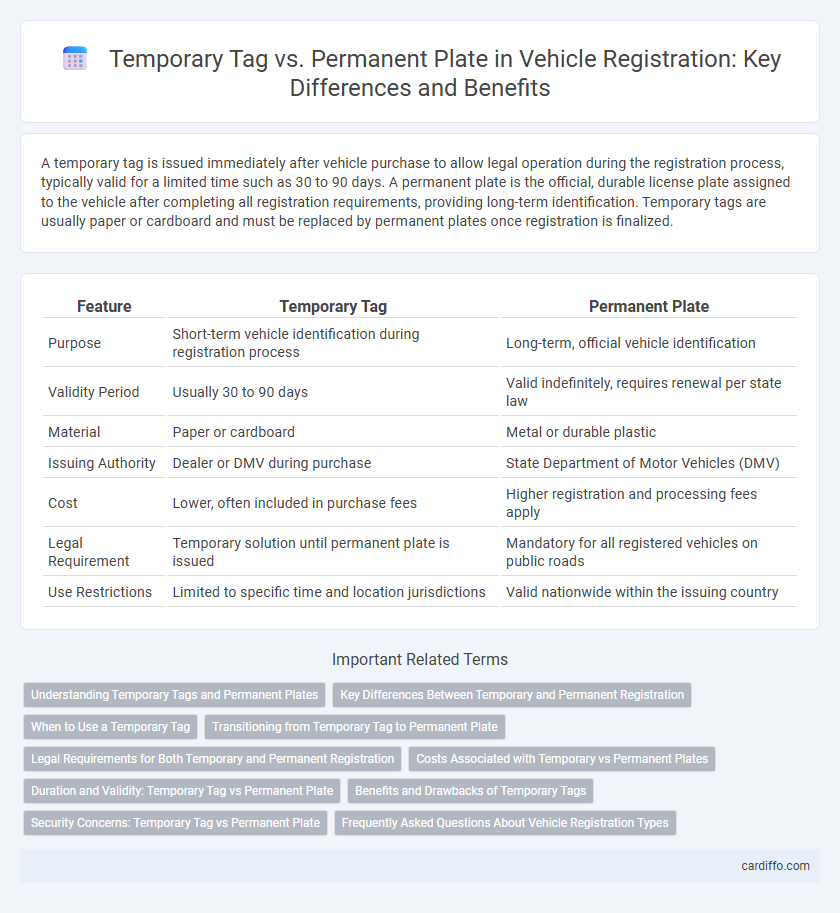A temporary tag is issued immediately after vehicle purchase to allow legal operation during the registration process, typically valid for a limited time such as 30 to 90 days. A permanent plate is the official, durable license plate assigned to the vehicle after completing all registration requirements, providing long-term identification. Temporary tags are usually paper or cardboard and must be replaced by permanent plates once registration is finalized.
Table of Comparison
| Feature | Temporary Tag | Permanent Plate |
|---|---|---|
| Purpose | Short-term vehicle identification during registration process | Long-term, official vehicle identification |
| Validity Period | Usually 30 to 90 days | Valid indefinitely, requires renewal per state law |
| Material | Paper or cardboard | Metal or durable plastic |
| Issuing Authority | Dealer or DMV during purchase | State Department of Motor Vehicles (DMV) |
| Cost | Lower, often included in purchase fees | Higher registration and processing fees apply |
| Legal Requirement | Temporary solution until permanent plate is issued | Mandatory for all registered vehicles on public roads |
| Use Restrictions | Limited to specific time and location jurisdictions | Valid nationwide within the issuing country |
Understanding Temporary Tags and Permanent Plates
Temporary tags provide short-term vehicle identification during the registration process, allowing legal operation before the permanent plate is issued. Permanent plates serve as the official, long-term vehicle identifier, typically made of durable materials and linked to the vehicle's registration records. Understanding the validity period, display requirements, and application procedures for both temporary tags and permanent plates ensures compliance with state regulations.
Key Differences Between Temporary and Permanent Registration
Temporary tags provide short-term vehicle identification for newly purchased cars, typically valid for 30 to 90 days, allowing legal use while awaiting permanent registration. Permanent plates offer long-term vehicle identification issued after completing all registration requirements, including proof of ownership and payment of registration fees, and they remain valid until renewal, usually annually. Key differences include the duration of validity, the issuance process, and legal recognition, with temporary tags serving as interim permits and permanent plates functioning as official, ongoing vehicle identifiers.
When to Use a Temporary Tag
Temporary tags are used when a vehicle is newly purchased and permanent plates have not yet been issued, allowing legal operation during the registration processing period. They are essential for short-term use, typically valid for 30 to 90 days, depending on state regulations. Temporary tags should be displayed immediately after purchase to comply with DMV requirements and avoid fines.
Transitioning from Temporary Tag to Permanent Plate
Transitioning from a temporary tag to a permanent plate requires submitting the vehicle registration application along with proof of insurance, identification, and payment of applicable fees to the department of motor vehicles (DMV). Temporary tags are valid for a limited period, typically 30 to 90 days, during which vehicle owners must complete the registration process to avoid penalties. Receiving a permanent plate officially documents ownership and allows lawful vehicle operation beyond the temporary tag's expiration.
Legal Requirements for Both Temporary and Permanent Registration
Temporary tags must be displayed immediately upon vehicle purchase and are valid for a limited period, usually 30 to 90 days, ensuring legal use before permanent registration is processed. Permanent plates require vehicle registration with the local Department of Motor Vehicles (DMV), proof of ownership, and payment of registration fees, meeting state-specific legal standards. Both temporary tags and permanent plates must comply with state laws, including proper display and timely renewal to avoid fines or penalties.
Costs Associated with Temporary vs Permanent Plates
Temporary tags typically cost between $10 and $30, offering a short-term solution for vehicle use during registration processing. Permanent plates usually require a higher upfront fee ranging from $50 to $150, which covers long-term registration and vehicle identification. Additional costs for permanent plates may include renewal fees and personalization options, making them more expensive over time compared to temporary tags.
Duration and Validity: Temporary Tag vs Permanent Plate
Temporary tags are typically valid for 30 to 90 days, providing short-term legal vehicle identification while permanent plates offer continuous validity for the vehicle's lifetime, subject to registration renewal laws. Temporary tags enable immediate vehicle use after purchase or transfer, whereas permanent plates require formal registration processing and issuance by motor vehicle authorities. The duration difference affects compliance, with temporary tags serving transitional needs and permanent plates ensuring long-term legal recognition.
Benefits and Drawbacks of Temporary Tags
Temporary tags provide immediate legal vehicle identification, allowing prompt use while awaiting permanent plates, but they often have limited validity periods and may not be accepted in all states. Their benefits include quick issuance and flexibility for new or out-of-state vehicle owners, while drawbacks involve potential fines if expiration is overlooked and reduced resale value perception. Permanent plates offer long-term assurance and compliance, but require more processing time before issuance.
Security Concerns: Temporary Tag vs Permanent Plate
Permanent plates offer enhanced security features such as tamper-resistant materials and embedded anti-theft technologies, reducing the risk of fraud and vehicle theft compared to temporary tags. Temporary tags, often printed on paper or flimsy materials, are more susceptible to forgery and illegal duplication, posing security challenges for law enforcement. The durability and traceability of permanent plates contribute significantly to improving vehicle identification and overall road safety.
Frequently Asked Questions About Vehicle Registration Types
Temporary tags provide a short-term vehicle identification solution, typically valid for 30 to 90 days, allowing owners time to complete permanent registration. Permanent plates are issued after successful registration and remain on the vehicle indefinitely, ensuring legal identification and compliance with state regulations. Vehicle owners frequently ask about the validity period of temporary tags, the transition process to permanent plates, and the associated fees and documentation requirements.
Temporary tag vs Permanent plate Infographic

 cardiffo.com
cardiffo.com